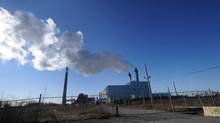Natural gas winning the race for energy efficiency
 Since 2007, the chorus has grown ever louder: Natural gas should have a bigger place in our North American energy diet – mostly as a substitute for high-carbon coal.
Since 2007, the chorus has grown ever louder: Natural gas should have a bigger place in our North American energy diet – mostly as a substitute for high-carbon coal.New-found abundance, cheap price and lower emissions are the reasons natural gas has been taking business away from coal barons, especially this year. But there is more to this fascinating business rivalry than a straight punch-up for market share. Energy conversion data in the U.S. electrical power sector is showing dramatic improvements in gas-fired power plant efficiency. In other words, it’s taking less natural gas to light up a bulb or dry someone’s hair.
Increasing efficiency in its use makes natural gas a doubly compelling fuel from a social and environmental standpoint. North American gas producers are in an enviable position to have a product that’s gaining acceptance – even though greater efficiency holds down growth in consumption for what they have to sell.
There are several primary ways to generate electricity: feeding uranium into a nuclear reactor; shovelling coal into a power plant; piping natural gas into a power plant; focusing sunlight onto a solar panel; and funnelling wind through a turbine. Efficiency is a measure of how much of the fuel energy going into these systems is actually turned into useful work.
In a car, we measure how many litres of gasoline are used to move us 100 kilometres. Similarly, in a power plant, the amount of input fuel needed to generate a unit of electrical energy defines the plant’s efficiency. The more electricity that’s put out by burning a cubic foot of natural gas, the more efficient is the system.
For hydrocarbons like coal and natural gas, achieving greater efficiency in power generation – in other words, burning less fuel to make more electricity – translates directly into emitting less carbon into the atmosphere. That’s an important goal in a climate-conscious world. Better efficiency within any one system also makes hydrocarbons more cost competitive against rivals competing for electric power market share.
The accompanying chart shows some remarkable efficiency data, comparing the averages of all natural gas and coal-fired power plants in the United States over the past 30 years. For each system, on a monthly basis, the data show the amount of electrical energy that is generating as a percentage of the fuel energy that’s input.
Between 1973 and 2000, both natural gas and coal systems were running fairly steady, with efficiencies tracking between 31 and 34 per cent. From a societal standpoint, the fact that only one-third of the energy in a pound of coal or a cubic foot of gas was actually used to make electricity, while two-thirds was blown out a smoke stack as unused heat, was a dismal state of affairs.
An aggressive buildup of high-efficiency “combined-cycle” natural gas power plants in the early 2000s began changing the game. Over the past 10 years, the average efficiency of natural gas plants has been improving continuously as more of these technologically superior systems were built and called upon to deliver power.
Although there is chatter in monthly numbers, the U.S. fleet of natural gas power plants is now achieving about 44 per cent efficiency. Rising from 32 per cent to 44 per cent is highly significant; compared to 10 years ago, an average utility today needs 27 per cent less natural gas to generate the same amount of electricity.
The trend in coal plants is unimpressive. Average efficiency of coal power plants has not changed in 30 years. In fact, there is a slight downward trend, in part because producing power while achieving progressively stricter environmental standards requires equipment that demands additional input energy. In other words, clean coal is achievable, but it’s not nearly as energy efficient as clean natural gas.
Power systems fed by natural gas – from wellhead to light switch – are becoming cleaner and more cost competitive, increasing their ability to take more market share away from coal (and renewables too). Producers will benefit from the increasing demand of fuel substitution – though their growth will be tempered by continuing improvements in the efficiency of the power plant.
Natural gas is the fuel of the future – not just because technology is allowing producers to find more at lower cost, but because technology is also allowing consumers to use it more sparingly.
You can return to the main Market News page, or press the Back button on your browser.

